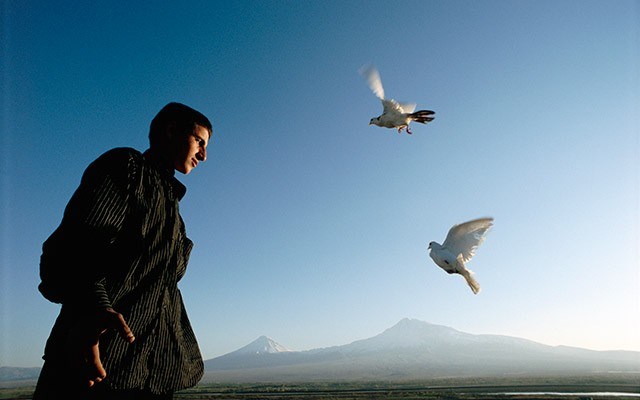Plato said "There are three kinds of people: those who are dead, those who are alive, and those who sail the seas."
Although this aphorism only recently came to photographer Ilja Herb's attention, it quickly became one of his faves — particularly poignant given that these days he lives on a sailboat named Foxy in an Esquimalt harbour just outside Victoria on Vancouver Island.
It's possible he was taking an uncharitable swipe at sailors (proving some things never change), but given the Greek philosopher's leanings and the unfathomable nature of oceans, Plato was more likely alluding to a state that differed from received views of both non-existence and existence. That of the wanderer caught between worlds — alive but unable to break the grip of a mortal drive for discovery and experience.
It turns out that Plato's musings are a reasonable approximation of Herb's life journey, but hold additional relevance: they also succinctly describe his photography.
From his earliest submissions to ski magazines, it was clear Herb appreciated good photojournalism, no matter the milieu, and sought to instate it in his own work. "It wasn't all that apparent in ski photography at the time," he recollects. "You needed the skills to make skiing look good, of course, but the formula was pretty simple: a sunny day, some powder, and a monkey who would jump off a rock. When you line up those elements it's more like a fashion shoot — something that's waiting for you — whereas journalistic photos are storytelling, chasing what's happening. I was always more drawn to that."
Born in Halifax, Nova Scotia, Herb grew up in Calgary, Alberta. His family relocated to Victoria when he was 12, where the outdoors beckoned and he became a "bona fide ski bum." A family vacation to Mt. Baker at 14 proved particularly formative. "I was reading Powder, loved the photos, and wanted to be one of those amazingly cool people in them. But I didn't have the balls to jump off a big cliff, so photographing it was the next best thing."
When, in his early twenties, he eventually did start shooting, street cred wasn't an issue: attending first to skiing and not so much to school, Herb sampled some of the world's most celebrated ski-bumming: St. Anton, Austria, and B.C. hotspots Rossland, Fernie, and Whistler.
"During the early '90s I had a sweet cycle going of guiding raft trips in Alaska and the Yukon in summers, and coming back with money to travel and go skiing for a few months. On the rivers I'd meet pro photographers who were my age now (40) and making good money. I loved skiing, and so the same thing seemed doable there. I started shooting, got a few photos published and that changed everything."
At that point, it was still a skill to reliably get the goods on film that you weren't able to look at. "The craft is still there today, but more obtainable because the recipe's more foolproof — though without film it has morphed into a different language."
Herb is grateful both to have worked with film, and to have become involved when assignments to remote places for proven photographers were more commonplace. "I'm lucky to have been able to go around the world with a little black box, frame things up and take pictures. That was my real education — cultures, places and seeing how other people live."
His first real overseas assignment was a Patagonia trip with Whistler snowboarder Kevin Smith and skier JD Hare. "They had a bit of budget — which was amazing to me — and we'd wanted to go to Alaska but it was having a shitty season. My cousin had just ridden a horse across Kyrgyzstan, so that's where we went. It was true adventure in beautiful mountains."
Soon he was travelling with sbcSKIER editor Jake Bogoch to places like Turkey, Georgia and Armenia, gaining reputation as a Central Asia specialist. "It was like: 'Let's send Ilja to the shittiest skiing in the world!' Well, more 'unlikely' skiing. I even had an assignment in Indiana."
For his part, Herb far preferred such novelty to developed resorts. "In places like that it's not about the pro or the amazing skier, but people who have no idea about magazines — like how much fun skiers in 'Durkadurkastan' have shredding on ancient technologies."
Though his arresting photos — many of which hover between the unexpected and the truly revealing — more than qualify, Herb has never been good at waving his own awesome flag. Finding self-promotion "rash-inducing," he has always preferred to fly under the radar. "The fact that some of my street photography got published in ski mags is a credit to editors who saw something interesting or a bit quirky that could deliver readers something different. I've been privileged to be able to walk a number of different paths, but there's a lot of other good things to do besides shoot pictures."
Like... buy a boat. Foxy gave Herb access to the labyrinthine B.C. coast, and he spent four months sailing and shooting the Great Bear Rainforest and other areas in 2012 with author Arno Kopecky, whose book, The Oil Man and the Sea documents the attitudes and issues around the proposed Enbridge Northern Gateway Pipeline from Alberta's toxic tar sands to the coast. "I feel like these are more important photos in that they aren't about shredding but opening the minds of people who don't understand what stands to be lost."
Of course, mobility is also key to the wanderer. "It's pretty great to be able to uproot and just move somewhere on a whim."
Indeed. From one world to another, as Plato might say.




